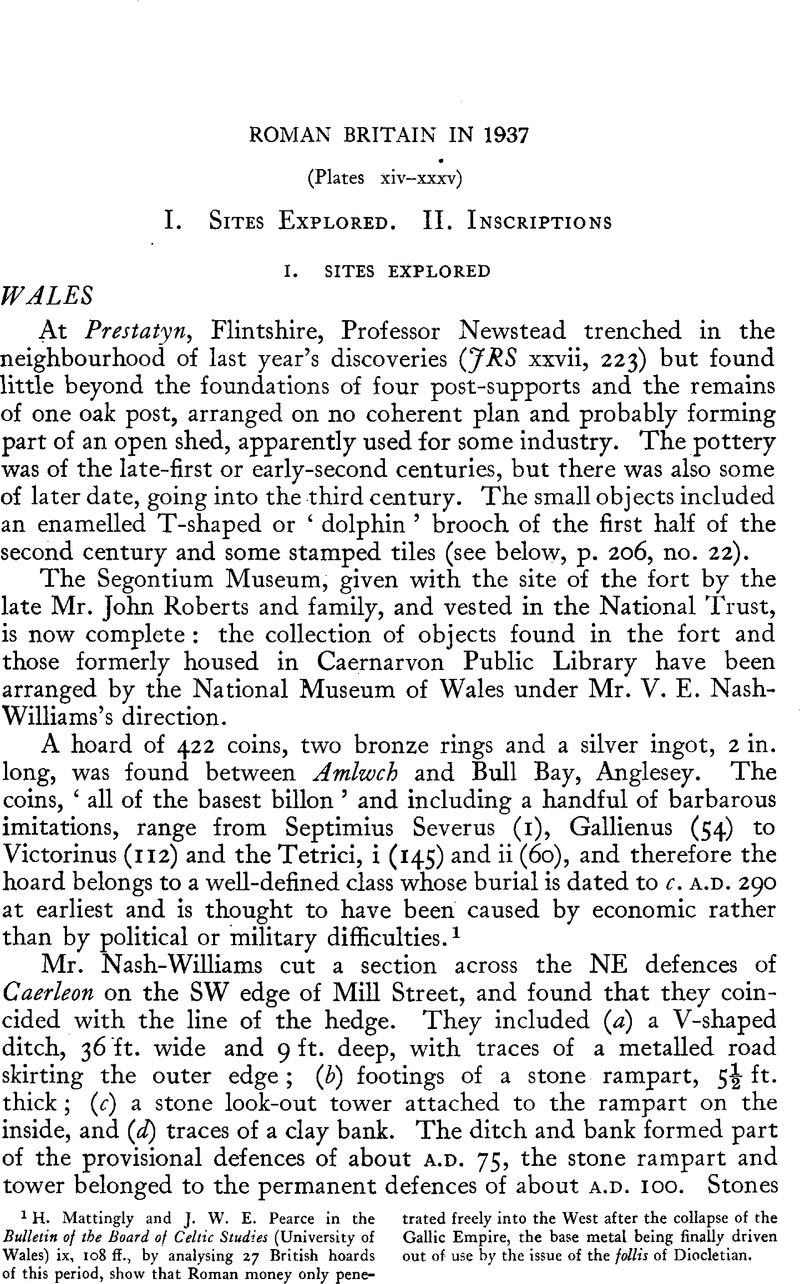No CrossRef data available.
Published online by Cambridge University Press: 24 September 2012

page 169 note 1 Mattingly, H. and Pearce, J. W. E. in the Bulletin of the Board of Celtic Studies (University of Wales) ix, 108 ff.Google Scholar, by analysing 27 British hoards of this period, show that Roman money only penetrated freely into the West after the collapse of the Gallic Empire, the base metal being finally driven out of use by the issue of the follis of Diocletian.
page 170 note 2 Arch. Cambr. xcii, 324 f.
page 170 note 3 Publication of this work awaits its completion in 1938.
page 170 note 4 Proc. Soc. of Antiqs. Scot. lxxi, 1936–1937, 382Google Scholar.
page 171 note 5 Forthcoming report in Glasgow Arch. Soc. Proc.
page 171 note 6 Forthcoming report in the Glasgow Arch. Soc. Proc.
page 172 note 7 Full report in Proc. Soc. Antiqs. Scot., 1937–8 276 ff.
page 173 note 8 Publication of these results awaits the completion of work upon adjacent portions of the site.
page 173 note 9 Arch. Aeliana, ser. 4, XV, 243–294.
page 174 note 10 Ibid. XV, 351 ff.
page 175 note 11 Ibid. xiv, 303 ff.
page 175 note 12 Trans. Cumb. and Westm. Antiq. and Arch. Soc., N.S., xxxviii, 195 ff.
page 177 note 13 Durham University Journ. XXX, 99 ff. and Arch. Ael., ser. 4, xv, 362 ff.
page 178 note 14 Vinovia (1891).
page 178 note 15 Bradford Antiquary vi (1938), 251 ff.Google Scholar
page 178 note 15a Yorks. Arch. Journ. xxxiv, 93.
page 179 note 16 Yorks. Arch. Journ. xxiii, 330, fig. 1, xxxiv, 102. No further work will be undertaken here but a full report will be issued.
page 179 note 17 Reprint from Trans, of East Riding Antiquarian Soc. xxviii, issued as Hull Museum Publication no. 198.
page 181 note 18 Chester and N. Wales Arch. Journ. viii, 1901. 93 ff.Google Scholar, xxvii, 183, pl. xxvi, no. lxx.
page 183 note 19 Dr. Garrood, in Antiqs. Journ. xviii, 76 ff.Google Scholar Dr. Garrood has also published in Tians. of Cambs. and Hunts. Arch. Soc., vol. v. a useful collection of addenda to the history of Godmanchester, including the F. G. Walker collection presented by the British Museum to Huntingdon Museum.
page 184 note 19a Information from Miss Diana Ashcroft whose report will be published in the Staffordshire Record Society's publication.
page 184 note 20 Information from the excavators, Dr. Hodgkinson and Dr. J. K. St. Joseph.
page 184 note 20a The Engineer, Jan. 1938, p. 26 fig.; they have been acquired by the British Museum.
page 185 note 21 Oxfordshire Arch. Soc. 1937, 23 ff., with illustrations of the hand-made wares derived from pre-Roman local types but in use in the late-first or early-second centuries.
page 185 note 22 Oxoniensia ii, 202 f.
page 185 note 23 Antiqs. Journ. xviii, 287.
page 185 note 24 Vict. Co. Hist. Herts iv, 147f.
page 185 note 24a Information from Mr. P. K. Baillie Reynolds.
page 187 note 25 St. Albans and Herts Archit. and Arch. Soc. Trans., 1937, 108 ff.; plan kindly sent by Mr. Lowther.
page 188 note 26 Antiqs. Journ. xviii, 339 ff. contains a detailed report, with interesting notes on local Belgic and early Roman pottery.
page 185 note 27 Norfolk Archaeology xxvi, 123 ff.
page 189 note 27a Information from Mr. M. R. Hull.
page 190 note 28 London and Middlesex Arch. Soc. Trans. N.S., 1937, 686.
page 190 note 29 Bristol and Gloucester Arch. Soc. Trans. lix, 337 ff.
page 190 note 30 Archaeologia lxix, 177, no. 26.
page 190 note 31 Num. Chron. xviii, ser. 5, 85 ff.
page 190 note 32 Bristol and Gloucester Arch. Soc. Trans. lix, 330 ff.
page 191 note 33 Somerset Arch. and NH Proc. lxxxiii, 155 ff.; Bath Branch of the Somerset Arch. and NH Proc. 1937, 182 ff.
page 191 note 34 Somerset Arch. and NH Proc. lxxxiii, 148 ff.
page 192 note 35 Cf. Dr. O'N. Hencken's report in Archaeologia lxxxiii, 237 ff.
page 194 note 36 Cf. JRS xxiii, 206, pl. xxiii for the chair leg, and ibid. xxii, 45 f., pl. xii for similar grotesque figures applied to bowls made in second-century kilns at Caister-by-Norwich.
page 194 note 37 Interim Report in Dorset NH and Arch. Soc. Proc. lix.
page 194 note 38 Wilts Arch. Mag. xxxviii, 188, xlv, 174.
page 194 note 39 H. Sumner, Excavations in New Forest Roman Pottery Sites, 76 ff., pls. 23, 24.
page 195 note 40 Hawkes, C. F. C., Antiqs. Journ. xviii, 113 ff.Google Scholar, ably shows the importance of this piece as testifying to the latent Celticism and surviving artistry of these New Forest potters. Mr. Hawkes dates Mr. Sumner's three periods to A.D. 250–390, 290–330 and after 330 and this piece to c. 300–320.
page 196 note 41 Information from Mrs. Hooley, Hon. Curator of the Winchester City Museum, where the head now is.
page 196 note 42 Information from Mr. C. F. C. Hawkes, who sent the photograph.
page 196 note 43 Mr. Goodchild points out that brooches of the same type with scenes in relief copied from coins have been found at Cold Kitchen Hill (now in Devizes Museum, Catalogue, 1934, part 2, p. 128, fig. 23) and Verulamium (Antiqs. Journ. xvii, 46, fig. 7, 1). It is hoped to publish this brooch shortly.
page 197 note 44 Sussex Arch. Collections lxxviii, 13 ff.
page 198 note 45 Forthcoming report by Miss Scott in Sussex Arch. Collections lxxix, 3 ff.
page 198 note 46 Information from Mr. J. B. Ward Perkins.
page 198 note 47 Information from Mr. C. F. C. Hawkes.
page 198 note 48 Photograph sent by Mr. C. E. Fisher.
page 198 note 49 Information from Mr. R. F. Jessup, the excavator.
page 199 note 1 We are indebted to Mr. Eric Birley for figs. 13–18